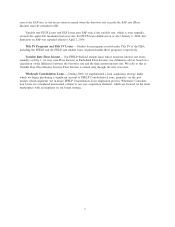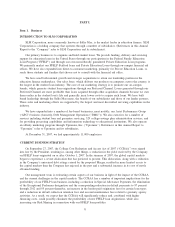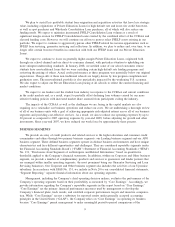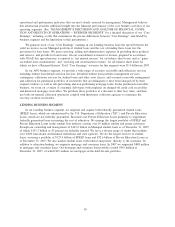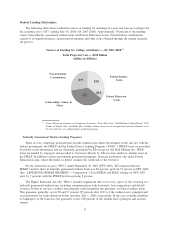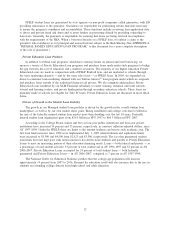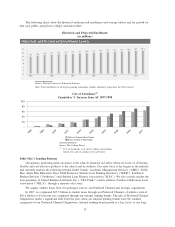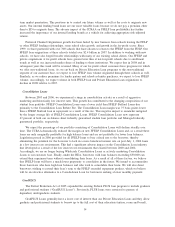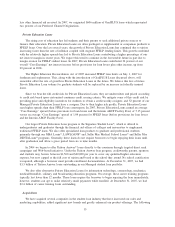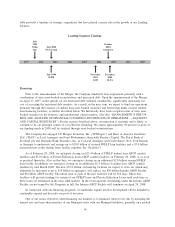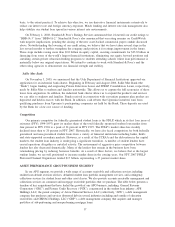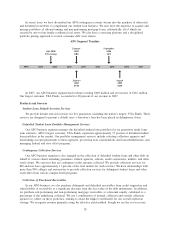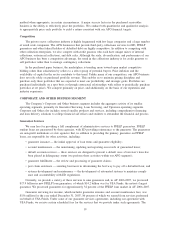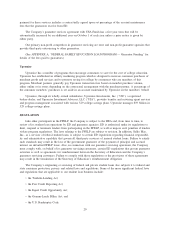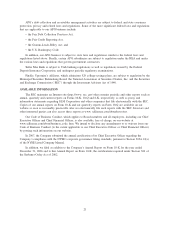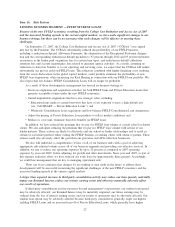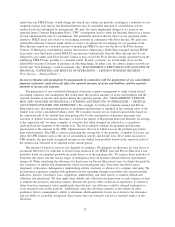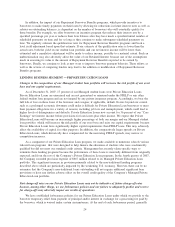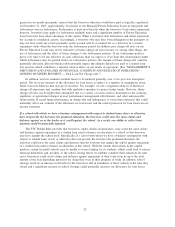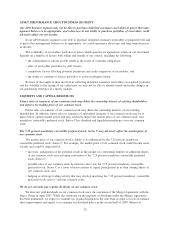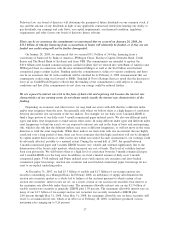Sallie Mae 2007 Annual Report Download - page 18
Download and view the complete annual report
Please find page 18 of the 2007 Sallie Mae annual report below. You can navigate through the pages in the report by either clicking on the pages listed below, or by using the keyword search tool below to find specific information within the annual report.basis, to the extent practical. To achieve this objective, we use derivative financial instruments extensively to
reduce our interest rate and foreign currency exposure. Match funding and interest rate risk management also
help stabilize our student loan spread in various interest rate environments.
On February 4, 2008, Standard & Poor’s Ratings Services announced that it lowered our credit ratings to
“BBB-/A-3” from “BBB+/A-2.” Standard & Poor’s also announced that our rating remains on CreditWatch
with negative implications, pending the closing of the new asset-backed commercial paper conduit discussed
above. Notwithstanding the lowering of our credit rating, we believe that we have taken several steps in the
last several months to further strengthen the company and position it for ratings improvement in the future.
These steps include raising more than $3.0 billion in equity capital, securing commitments for $33.8 billion in
financing from some of the world’s largest financial institutions, eliminating our equity forward positions and
curtailing certain private education lending programs to students attending schools where loan performance is
materially below our original expectations. We intend to continue to work with Standard & Poor’s and the
other rating agencies to demonstrate our financial strength and stability.
Sallie Mae Bank
On November 3, 2005, we announced that the Utah Department of Financial Institutions approved our
application for an industrial bank charter. Beginning in February and August 2006, Sallie Mae Bank (the
“Bank”) began funding and originating Private Education Loans and FFELP Consolidation Loans, respectively,
made by Sallie Mae to students and families nationwide. This allows us to capture the full economics of these
loans from origination. In addition, the industrial bank charter allows us to expand the products and services
we can offer to students and families. Funds received in connection with our tuition payment plan product are
deposited and held in escrow with the Bank. In addition, cash rebates that Upromise members earn from
qualifying purchases from Upromise’s participating companies are held by the Bank. These deposits are used
by the Bank for a low cost source of funding.
Competition
Our primary competitor for federally guaranteed student loans is the FDLP, which in its first four years of
existence (FFYs 1994-1997) grew its market share of the total federally sponsored student loan market from
four percent in FFY 1994 to a peak of 34 percent in FFY 1997. The FDLP’s market share has steadily
declined since then to 20 percent in FFY 2007. Historically, we have also faced competition for both federally
guaranteed and non-guaranteed student loans from a variety of financial institutions including banks, thrifts
and state-supported secondary markets. However, as a result of the CCRAA and the dislocation in the capital
markets, the student loan industry is undergoing a significant transition. A number of student lenders have
ceased operations altogether or curtailed activity. The environment of aggressive price competition between
lenders has also decreased dramatically. Many of the lenders that remain in the business have been
rationalizing pricing by reducing borrower benefits. As a result of these factors, we believe that as the largest
student lender, we are well positioned to increase market share in the coming years. Our FFY 2007 FFELP
Preferred Channel Originations totaled $17 billion, representing a 27 percent market share.
ASSET PERFORMANCE GROUP BUSINESS SEGMENT
In our APG segment, we provide a wide range of accounts receivable and collections services including
student loan default aversion services, defaulted student loan portfolio management services, and contingency
collections services for student loans and other asset classes. We also provide accounts receivable management and
collections services on consumer and mortgage receivable portfolios that we purchase. The table below presents a
timeline of key acquisitions that have fueled the growth of our APG business, including: General Revenue
Corporation (“GRC”) and Pioneer Credit Recovery (“PCR”), concentrated in the student loan industry; AFS
Holdings, LLC, the parent company of Arrow Financial Services, LLC (collectively, “AFS”), a debt management
company that purchases and services distressed debt in several industries including and outside of education
receivables; and GRP/AG Holdings, LLC (“GRP”), a debt management company that acquires and manages
portfolios of sub-performing and non-performing mortgage loans.
17


